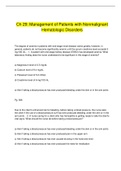Ch 29: Management of Patients with Nonmalignant Hematologic Disorders The degree of anemia in patients with end -stage renal disease varies greatly; however, in general, patients do not become significantly anemic until the serum creatinine level exceeds 3 mg/100 mL. - 1. A patient with end -stage kidney disease (ESKD) has developed anemia. What laboratory finding does the nurse understand to be significant in this stage of anemia? a) Magnesium level of 2.5 mg/dL b) Calcium level of 9.4 mg/d L c) Potassium level of 5.2 mEq/L d) Creatinine level of 6 mg/100 mL a) Ask if taking a blood pressure has ever produced bleeding under the skin or in the arm joints Pg. 936 Due to the client's enhanced risk for bleeding, before taking a blood pressure, the nurse asks the client if the use of a blood -pressure cuff has ever produced bleeding under the skin or in the arm joints. - 2. A nurse caring for a client who has hemophilia is getting ready to take the client's vital signs. What should the nurse do b efore taking a blood pressure? a) Ask if taking a blood pressure has ever produced bleeding under the skin or in the arm joints b) Ask if taking a blood pressure has ever produced pain in the upper arm c) Ask if taking a blood pressure has ever caused bru ising in the hand and wrist d) Ask if taking a blood pressure has ever produced the need for medication b) Gradually taper the dose and frequency of medication Pg. 932 For a patient with thrombocytopenia, he or she gradually tapers the dose and frequenc y of steroid medication before discontinuing it to avoid adrenal insufficiency or crisis. Eliminating aspirin and NSAIDS will help manage bleeding tendencies. Assessment of the extremities, tonsils, or the lymph nodes is part of a physical examination of a patient and not applicable to corticosteroid therapy. - 3. A patient has been diagnosed with thrombocytopenia. What are the primary nursing interventions while instituting corticosteroid therapy in this patient? a) Examine the extremities for redness b) Gradually taper the dose and frequency of medication c) Eliminate aspirin and nonsteroidal anti -inflammatory drugs (NSAIDs) d) Palpate the lymph nodes and tonsils every shift a) Platelet count, prothrombin time, and partial thromboplastin time Pg. 940 The diagnosis of DIC is based on the results of laboratory studies of prothrombin time, platelet count, thrombin time, partial thromboplastin time, and fibrinogen level as well as client history and other assessment factors. Blood glucose levels, WBC cou nt, calcium levels, and potassium levels aren't used to confirm a diagnosis of DIC. - 4. While monitoring a client for the development of disseminated intravascular coagulation (DIC), the nurse should take note of which assessment parameters? a) Platelet count, prothrombin time, and partial thromboplastin time b) Fibrinogen level, WBC, and platelet count c) Platelet count, blood glucose levels, and white blood cell (WBC) count d) Thrombin time, calcium levels, and potassium levels b) Slow the rate of the transfusion and obtain an order for furosemide Pg. 933 The description is consistent with a client who is experiencing circulatory overload. The nurse is to slow the rate of the transfusion and administer a diuretic. Oxygen is administered with a prescri ption and for severe dyspnea. This option does not allow for the nurse to slow the transfusion. The nurse would still be administering the blood at the current rate of 125 mL/hour. Diphenhydramine (Benadryl) would be prescribed for an allergic reaction. Bl ood and urine specimens are obtained for acute hemolytic reactions. - 5. An older adult client is to receive 2 units of packed red blood cells. During the transfusion of the first unit at 125 mL/hour, the client reports shortness of breath 30 minutes into the process. The client exhibits the vital signs shown in the accompanying table. What is the nurse's best intervention? a) Administer oxygen through nasal cannula at 2 L/minute b) Slow the rate of the transfusion and obtain an order for furosemide b) A hemolytic allergic reaction caused by an antigen reaction Pg. Hemolytic allergic reactions are fairly common and may cause chills, fever, urticaria, tachycardia, dyspnea, chest pain, hypotension, and other signs of anaphylaxis a few minutes after blood transfusion begins. Although rare, a hemolytic reaction to mismat ched blood can occur, triggering a more severe reaction and, possibly, leading to disseminated intravascular coagulation. A hemolytic reaction to Rh -incompatible blood is less severe and occurs several days to 2 weeks after the transfusion. Bacterial conta mination of donor blood causes a high fever, nausea, vomiting, diarrhea, abdominal cramps and, possibly, shock. - 6. A few minutes after beginning a blood transfusion, a nurse notes that a client has chills, dyspnea, and urticaria.




